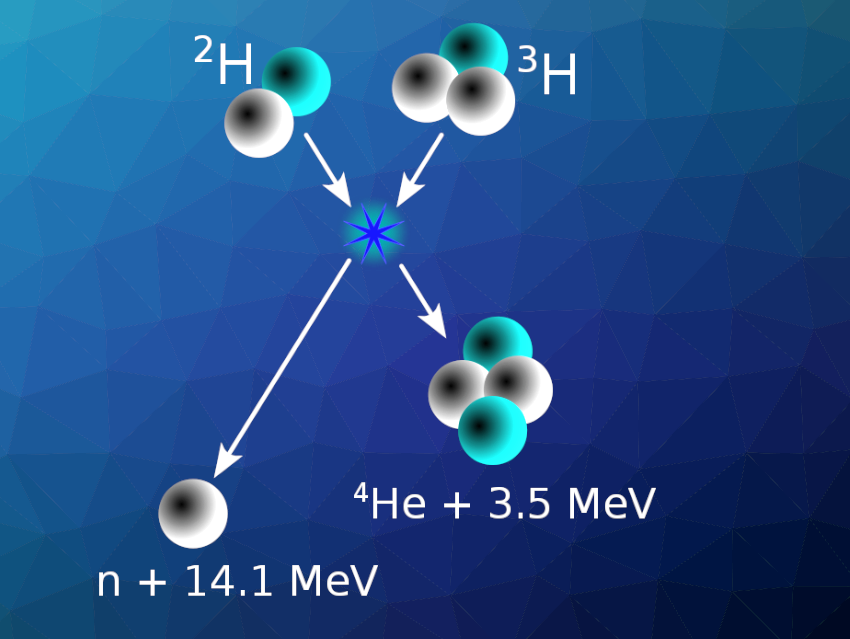Researchers at the government-owned Lawrence Livermore National Laboratory (LLNL), CA, USA, say they have succeeded for the first time in releasing more energy in a fusion experiment than it consumed. If the report is confirmed – the data are still being evaluated – this could be proof that controlled fusion is possible. This would be an important step for further research. It is still a long way with many challenges to solve from using this as a technology to provide a carbon-free alternative to fossil fuels.
The team achieved a net energy of 2.5 megajoules (MJ) with a laser of 2.1 MJ, and the achievement of up to 3 megajoules might be possible. Experiments in January 2022 already achieved 1.3 MJ with a laser shot of 1.7 MJ [1]. This shows the mechanism of propagation of the thermal combustion wave in the fuel and suggests that more energy can be obtained in this process.
“Although positive news, this result is still a long way from the actual energy gain required for the production of electricity”, according to Tony Roulstone, lecturer in nuclear energy at the University of Cambridge, UK. “That’s because they had to use 500 MJ of energy into the lasers to deliver 1.8 MJ to the target – so even though they got 2.5 MJ out, it’s still far less than the energy they needed for the lasers in the first place. In other words, the energy output (largely heat energy) was still only 0.5% of the input. An engineering target for fusion would be to recover much of the energy used in the process and get an energy gain of double the energy that went into the lasers – it needs to be double because the heat must be converted to electricity and you lose energy that way.”
Nuclear fusion refers to nuclear reactions in which two atomic nuclei (mainly deuterium(2H) and tritium (3H)) each fuse to form a new nucleus (4He), releasing a neutron (n) as well as energy. Nuclear fusion reactions are the cause of the Sun and all luminous stars radiating energy. Physicists have been trying to harness the fusion reaction since the 1950s, but no group has yet been able to extract more energy from the reaction than it consumes.
A press conference will be held on December 13 in Washington D.C. by U.S. Energy Secretary Jennifer M. Grandholm and Under Secretary for Nuclear Security and National Nuclear Security Administration Jill Hruby.
- Tom Wilson, Fusion energy breakthrough by US scientists boosts clean power hopes, Financial Times December 11, 2022.
[1] A. B. Zylstra, O. A. Hurricane, D. A. Callahan, A. L. Kritcher, J. E. Ralph, H. F. Robey, J. S. Ross, C. V. Young, K. L. Baker, D. T. Casey, T. D�ppner, L. Divol, M. Hohenberger, S. Le Pape, A. Pak, P. K. Patel, R. Tommasini, S. J. Ali, P. A. Amendt, L. J. Atherton, B. Bachmann, D. Bailey, L. R. Benedetti, L. Berzak Hopkins, R. Betti, S. D. Bhandarkar, J. Biener, R. M. Bionta, N. W. Birge, E. J. Bond, D. K. Bradley, T. Braun, T. M. Briggs, M. W. Bruhn, P. M. Celliers, B. Chang, T. Chapman, H. Chen, C. Choate, A. R. Christopherson, D. S. Clark, J. W. Crippen, E. L. Dewald, T. R. Dittrich, M. J. Edwards, W. A. Farmer, J. E. Field, D. Fittinghoff, J. Frenje, J. Gaffney, M. Gatu Johnson, S. H. Glenzer, G. P. Grim, S. Haan, K. D. Hahn, G. N. Hall, B. A. Hammel, J. Harte, E. Hartouni, J. E. Heebner, V. J. Hernandez, H. Herrmann, M. C. Herrmann, D. E. Hinkel, D. D. Ho, J. P. Holder, W. W. Hsing, H. Huang, K. D. Humbird, N. Izumi, L. C. Jarrott, J. Jeet, O. Jones, G. D. Kerbel, S. M. Kerr, S. F. Khan, J. Kilkenny, Y. Kim, H. Geppert Kleinrath, V. Geppert Kleinrath, C. Kong, J. M. Koning, J. J. Kroll, M. K. G. Kruse, B. Kustowski, O. L. Landen, S. Langer, D. Larson, N. C. Lemos, J. D. Lindl, T. Ma, M. J. MacDonald, B. J. MacGowan, A. J. Mackinnon, S. A. MacLaren, A. G. MacPhee, M. M. Marinak, D. A. Mariscal, E. V. Marley, L. Masse, K. Meaney, N. B. Meezan, P. A. Michel, M. Millot, J. L. Milovich, J. D. Moody, A. S. Moore, J. W. Morton, T. Murphy, K. Newman, J.-M. G. Di Nicola, A. Nikroo, R. Nora, M. V. Patel, L. J. Pelz, J. L. Peterson, Y. Ping, B. B. Pollock, M. Ratledge, N. G. Rice, H. Rinderknecht, M. Rosen, M. S. Rubery, J. D. Salmonson, J. Sater, S. Schiaffino, D. J. Schlossberg, M. B. Schneider, C. R. Schroeder, H. A. Scott, S. M. Sepke, K. Sequoia, M. W. Sherlock, S. Shin, V. A. Smalyuk, B. K. Spears, P. T. Springer, M. Stadermann, S. Stoupin, D. J. Strozzi, L. J. Suter, C. A. Thomas, R. P. J. Town, E. R. Tubman, C. Trosseille, P. L. Volegov, C. R. Weber, K. Widmann, C. Wild, C. H. Wilde, B. M. Van Wonterghem, D. T. Woods, B. N. Woodworth, M. Yamaguchi, S. T. Yang, G. B. Zimmerman, Burning plasma achieved in inertial fusion, Nature 2022, 601, 542–548. https://doi.org/10.1038/s41586-021-04281-w
Update December 13, 2022
The U.S. Department of Energy responsible for the institute plans a press conference today, Dec 13 @ 4 PM CET/10 AM EST to present the result. If the report stands up to independent scrutiny, it would indeed be an important step on the road to controlled fusion.




